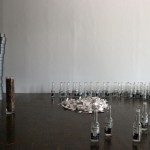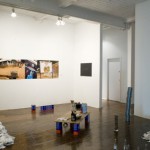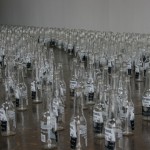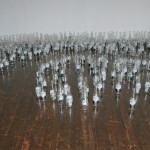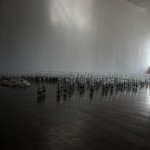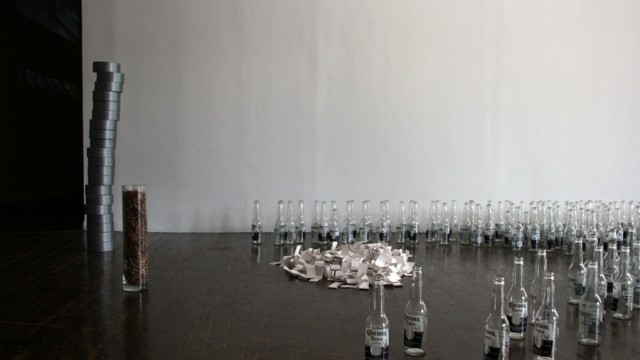
Assembly
2008
participatory installation with empty Corona bottles, rags, duct tape, turpentine, denatured alcohol, matches, matchbooks, motor oil, funnel, screwdriver, hammer, floodlight. Dimensions variable. Installation detail.
Part of the exhibition Live and Active at BRAC ; Exhibition essay here.
Assembly consists of an “artful” arrangement of materials necessary to build home-made weaponry, like Molotov cocktails. They are displayed so they are collected by not assembled, never reaching their illegal or volatile state, only suggesting it. A wall text indicates that the materials may be touched and taken. The intention and purpose of the work is left to the viewer to decide and activate. According to current law, these materials are all legal to have and combine to some extent, but become illegal if it can be proved that there is malicious ‘intent,’ which the is left open to interpretation. The work hopes to suggest that art, and the ideas contained within it, can be active, volatile and empowering, when fully realized.
Assemblyis designed to be placed in a gallery, on a ground floor, in a window, making it visible from the outside, but locating it within the world of art, fiction and artifice. The piece seeks to discuss the moment of action or activation in a work of art, and the moment of decision in an individual’s encounter with potentially volatile, powerful and dangerous materials. The piece is inspired by Joseph Beuys’s installations with felt and batteries, which create an active field, and the potential for further charge by the proximity of his materials. The work also is the result of the my research into the history of home-made or hand-crafted weaponry, such as Molotov cocktails, which were originally hand made and then eventually mass-produced in assembly lines, and which also seem to be recurring in recent art works as important hand made or mass reproduced icons (Joywar, etc.) The work examines the lines between art and craft, between craft and fabrication, between the artist and the receiver, and attempts to relegate the power of the art object, and some of the creative or destructive act, to its audience. Similarly, the work discusses the idea of ‘intention’ and the particularly protected yet impotent role that out society has created for art works.
